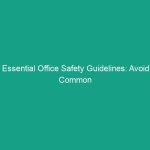Good Morning Team!
Today, we are going to discuss an important topic that directly impacts our health and Safety: Essential Oil Response Guidelines. Understanding these guidelines will help us avoid common mistakes and risks associated with essential oil use in the workplace. This is crucial not only for our well-being but also for maintaining a safe and productive work Environment.
Understanding Essential Oil Response Guidelines
Essential Oil Response Guidelines refer to the Safety protocols and Best Practices for handling, using, and responding to essential oils in a workplace setting. As essential oils become increasingly popular for their therapeutic properties, it is vital to implement Safety Measures to avoid adverse reactions, both to the oils themselves and any potential Hazards they may introduce.
Many employees may think that essential oils are harmless because they are natural. However, it’s important to recognize that they can pose risks if not handled properly. Misunderstandings about their safety can lead to accidents or health issues, which is why we must prioritize these guidelines.
Key Hazards, Risks, and Safety Considerations
When working with essential oils, there are specific hazards and risks to be aware of:
- Skin Irritation: Many essential oils can cause allergic reactions or skin irritations. Always perform a patch test before using a new oil.
- Respiratory Issues: Some oils can irritate the respiratory system, especially in individuals with pre-existing conditions like asthma.
- Flammability: Certain essential oils are flammable and should be stored and used away from heat sources.
- Ingestion Risks: Essential oils are highly concentrated and can be toxic if ingested. Always keep them out of reach of children and pets.
- Contamination: Cross-contamination can occur if oils are not stored properly or if equipment is not cleaned after use.
The real-world consequences of ignoring these safety protocols can include health complications, workplace accidents, and even legal repercussions for the company. It’s crucial to understand that our safety is interconnected, and proper adherence to these guidelines protects everyone.
Best Practices, Procedures, & Actionable Advice
To ensure the safe use of essential oils, here are some Best Practices and Procedures to follow:
1. Education and Training
Before using essential oils, employees should undergo training on their properties and Safety Guidelines. Regular workshops can help keep everyone informed about the latest safety practices.
2. Safe Handling of Essential Oils
When handling essential oils, always:
- Wear gloves to protect your skin.
- Use a dropper or pipette to dispense oils to prevent spills.
- Label all containers clearly to avoid confusion.
- Store oils in a cool, dark place away from direct sunlight.
3. Emergency Response Procedures
In the event of an accidental exposure or reaction, follow these steps:
- For skin irritation, wash the affected area immediately with soap and water.
- If ingestion occurs, seek medical assistance immediately. Do not induce vomiting unless instructed by a medical professional.
- For respiratory irritation, move to fresh air and seek medical help if symptoms persist.
Regularly review these procedures and conduct drills to ensure everyone knows what to do in case of an emergency.
4. Real-Life Example
Consider the case of a colleague who mixed an essential oil with a carrier oil without checking for skin sensitivities. They experienced a severe allergic reaction, highlighting the importance of knowledge and caution when using these products. Always consult safety data sheets and company guidelines before use.
Regulations, Standards, and Compliance
Adhering to safety Regulations is not just a legal requirement; it’s a moral obligation to protect our health. Familiarize yourself with the following Standards:
- OSHA‘s Hazard Communication Standard (HCS) which mandates proper labeling and safety data sheets.
- ISO 9001 for quality management systems, ensuring consistent service and safety.
- Company-specific policies regarding the use of essential oils and other hazardous materials.
Compliance with these regulations is critical as it not only protects employees but also minimizes liability for the company. Always stay updated with any changes in regulations and participate in training sessions offered by the company.
Employee Engagement & Discussion
Now, let’s open the floor for discussion. Here are some questions to consider:
- What safety challenges have you encountered related to essential oils?
- Do you feel confident in your knowledge of essential oil safety?
- How can we improve our current safety practices regarding essential oils?
Your input is invaluable in creating a safer working environment. Sharing experiences and suggestions can lead to meaningful improvements in our safety protocols.
Conclusion & Key Takeaways
In conclusion, understanding and applying the Essential Oil Response Guidelines is essential for our safety. Remember the key points:
- Always educate yourself about the essential oils you use.
- Follow safe handling practices to minimize risks.
- Be prepared for emergencies with clear response procedures.
- Stay compliant with safety regulations and company policies.
Let’s make a commitment to prioritize safety and support each other in this effort. Thank you for your attention and your dedication to creating a safe work environment. Together, we can mitigate risks and promote wellness in the workplace!


